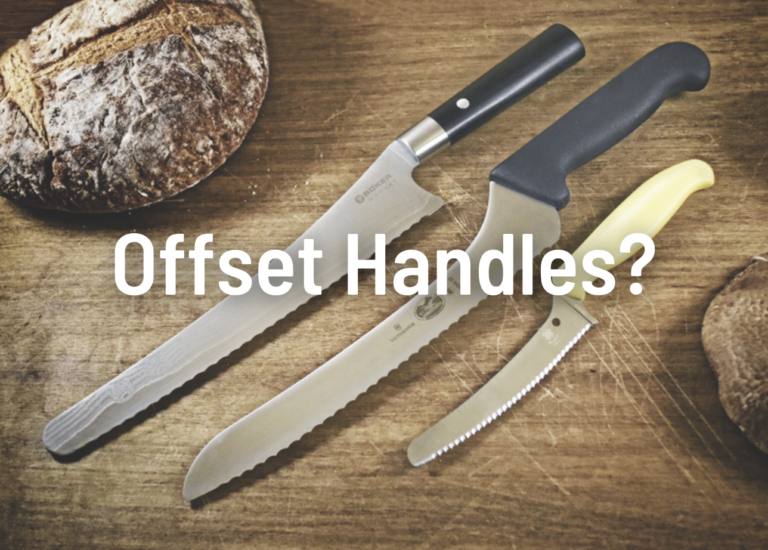
The offset handle may just save your skin during meal prep
Most will agree that offset handles on kitchen knives look just a bit funky, but have you ever pondered why the unusual “stepped design” is what it is? Actually, there’s a method to the madness and it’s really quite simple. It’s to save your knuckles from getting banged up while slicing. Little has been written about this unusual handle, so we thought it would be both fun and informative to give a handful of o set-handle kitchen knives a spin around the cutting board.
It should be noted that such cutters often are referred to as bread* or sandwich knives which, when you think about it, makes sense, since loaves of bread typically have largish, at bottoms that require getting the digits down low when cutting. Plus, like the majority of bread knives, most are serrated.
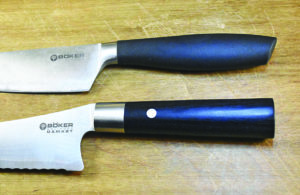
The test knives have full serrations and, interestingly, there is a slight bow to the blades as well. The slight curve enables you to rock the blade back and forth on all cutting to make sure the cut is complete, a trait common to most cleavers as well. Serrations are a double-edged sword, so to speak, in that they make it easy to saw through most media. The other edge of the sword is that they can be a nightmare to sharpen, a feat some prefer to job out to the factory or professionals. However, serrations work particularly well at food prep for many breads, meats and vegetables, which is why so many kitchen knives of all types have them. Note that the featured models are hidden-tang knives—all the better to keep unwanted fluids out of the nooks and crannies found on their full-tang counterparts.
KITCHEN CUTTERS
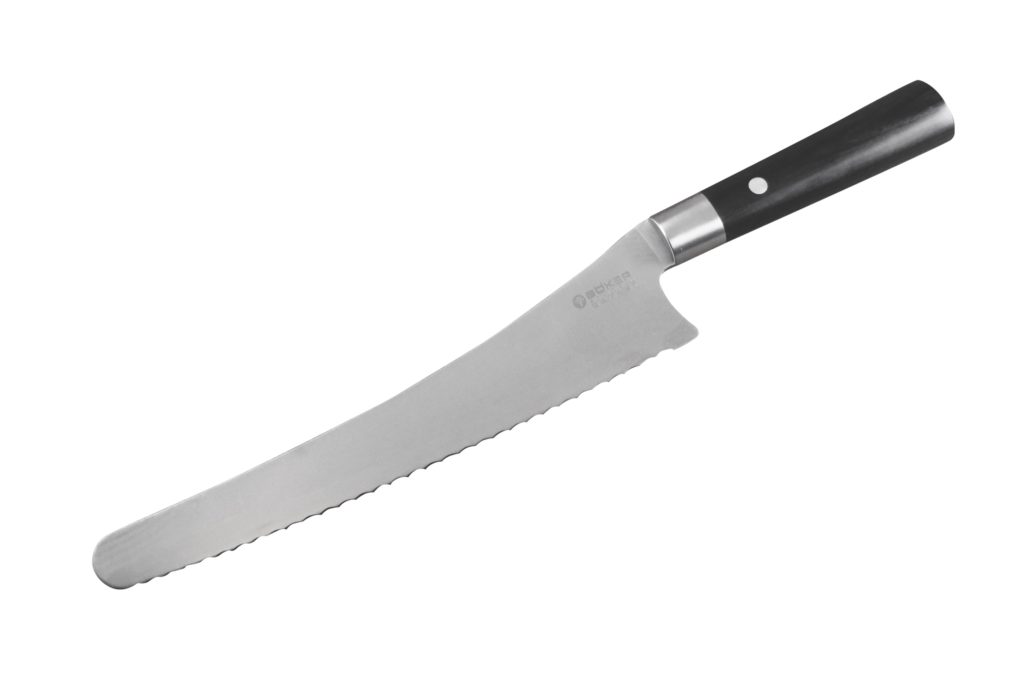
The Boker Black Damascus Bread Knife is the high-priced spread, pun intended. It is a large bread knife but is extremely lightweight due to its very thin blade. The blunt-tipped pattern has full serrations, each approximately .25 inch long. According to a Boker spokesperson, the blade’s core is VG-10 stainless. The damascus pattern is forged of various stainless steels by Japan’s Takefu Special Steel, Ltd. The blade is all business as there is no effort to etch the damascus, though the pattern is faintly visible. The ovate handle is topped with a stainless steel bolster.
The Spyderco Blunt-Tip Z-Cut is the smallest of the test slicers. Billed as a “go-to knife for all food preparation chores,” its blade has fine .125-inch serrations along the edge. The CTS BD1N stainless blade steel is made by Carpenter Technology, a leader in the industry, and is considered much better than common culinary alloys. The handle is yellow polypropylene, a common synthetic found on many kitchen knives because it is dense and repels water. The Blunt-Tip Z-Cut is super lightweight.
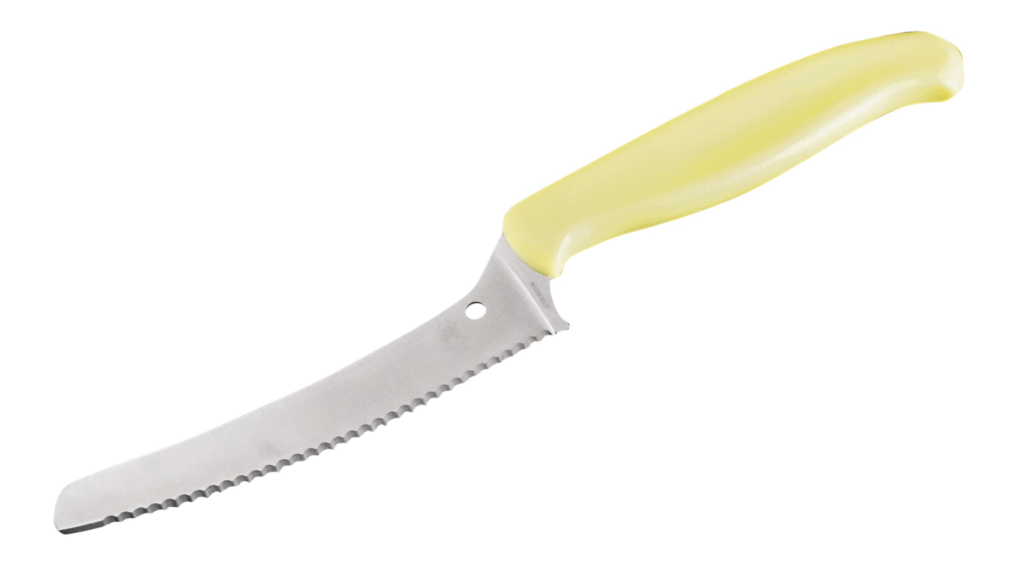
The Victorinox 9-inch Offset Sandwich Knife is the largest and heaviest of the test bunch, edging out its Boker counterpart by a half inch and a half ounce. Victorinox has always been hush-hush about its proprietary steels but does indicate that the blade is stainless steel with a carbon content of .5 percent^. e blade has .25-inch serrations and the ample handle is a black synthetic. After its acclaimed Swiss Army knives, Victorinox is well known for the Forschner brand kitchen knives, which it has owned controlling stock in since 1981.
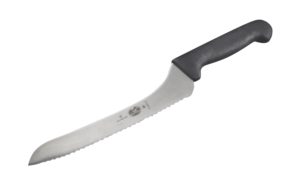
TASTY TESTING
I tested the two large o set knives sideby-side as their specs were so similar, starting with a 4×7-inch loaf of Publix Tuscan Boule bread. Unlike run-of-the-mill white bread, Tuscan Boule has a very tough rind. Using the knives in sawing strokes, I took off quarter- to half-inch slices. Both knives performed admirably, giving me any grief only on the at base of the loaf due to its full 7-inch rind. Once I got used to rocking the blade on the final cut, this, too, made for quick business. My biggest takeaway, however, was that offset handles do indeed work! In fact, I didn’t come anywhere close to busting a knuckle. My knuckles tapped the cutting board top a few times, but nowhere near as badly had I been using a handle without the offset. Both the Boker and Victorinox were comfortable in the hand, with the latter having an edge due to its fat, curvaceous—not to mention slightly longer—handle, though you’d be fine with either knife.
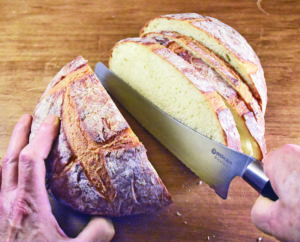
Next I took the knives outside the Bread Zone, testing them on other foodstuffs such as corned beef and Cajun sausage. Both knives sliced extremely well. Indeed, you could make an entire sandwich using these knives—but would you want to? By doing so you’d dull your serrations faster, even if minutely. It may be better to stick to bread and let your other kitchen knives share the cutting chores.
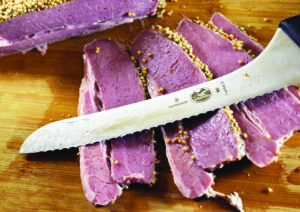
The Spyderco Blunt-Tip Z-Cut is a smaller, handier version of the two bigger models, mainly because you need not drag out a large cutting board to use it. It’s not going to slice its way through a large loaf like the Tuscan Boule, but it will whip its way through a smaller sub-style sandwich or your standard white bread lunch quickie. I also gave it a spin slicing tomatoes, portobello mushrooms and a 3-inch chub of summer sausage. The knife performed very well and is limited only by its size. The Blunt-Tip Z-Cut’s blade is scary sharp—not surprising since serrations have been in Spyderco’s wheelhouse for quite a while. Where’s also a plain-edge version of the knife available—the Pointed Z-Cut. These two make for good companion knives and the plain-edge version will cut down your use of the serrated one.
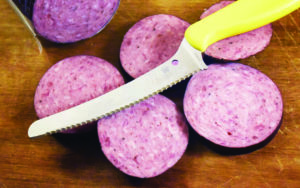
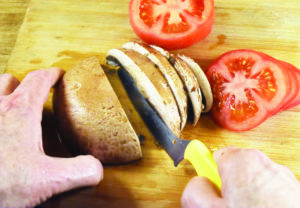
CHOICES ABOUND
All of the test knives were wicked sharp. You might ask yourself, if the two large bread knives cut equally well, why pay such a higher price for the Boker? For the same reason some carry affordable Kershaw folders as their EDC and others spend much more on a Chris Reeve: choices abound in the culinary world, just as they do in the EDC realm.
*Editor’s note: Standard bread knives have conventional, straight handles.
^Medium carbon steel has a carbon content of approximately .3 to .59 percent. High carbon steel has a carbon content of approximately .6 to .99 percent.
 NEXT STEP: Download Your Free KNIFE GUIDE Issue of BLADE Magazine
NEXT STEP: Download Your Free KNIFE GUIDE Issue of BLADE Magazine
BLADE’s annual Knife Guide Issue features the newest knives and sharpeners, plus knife and axe reviews, knife sheaths, kit knives and a Knife Industry Directory.Get your FREE digital PDF instant download of the annual Knife Guide. No, really! We will email it to you right now when you subscribe to the BLADE email newsletter.






